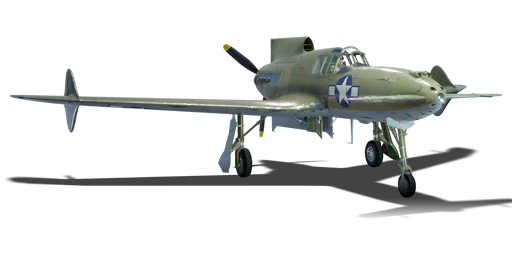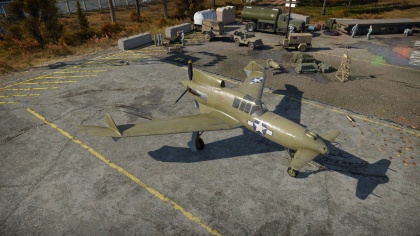XP-55
Contents
Description
The XP-55 Ascender is a Rank III premium American fighter
with a battle rating of 3.7 (AB), 4.3 (RB), and 3.0 (SB). It was introduced in Update 1.31 and costs 3,900 GE.
The XP-55 Ascender is unlike anything you will fly in the U.S. Tech Tree. Flying this aircraft effectively requires a dedication to Energy Fighting. The XP-55 excels greatly in the ability to climb and dive and this is your greatest advantage. The Ascender has decent maneuverability and best used in a Boom & Zoom function. All four of this aircraft's armament are packed tightly in the nose for devastating results.
General info
Flight Performance
| Characteristics | |||||||
|---|---|---|---|---|---|---|---|
| Stock | |||||||
| Max Speed (km/h at 5,000 m) |
Max altitude (meters) |
Turn time (seconds) |
Rate of climb (meters/second) |
Take-off run (meters) | |||
| ABN1K2-J | RB | AB | RB | AB | RB | ||
| 601 | 589 | 10500 | 30.3 | 30.8 | 13.3 | 15.3 | 232 |
| Upgraded | |||||||
| Max Speed (km/h at 5,000 m) |
Max altitude (meters) | Turn time (seconds) | Rate of climb (meters/second) |
Take-off run (meters) | |||
| AB | RB | AB | RB | AB | RB | ||
| 656 | 628 | 10500 | 28.8 | 29.2 | 26.2 | 18.6 | 232 |
Details
| Features | ||||
|---|---|---|---|---|
| Combat flap | Take-off flap | Landing flap | Air brakes | Arrestor gear |
| ✓ | ✓ | ✓ | X | X |
| Limits | ||||
|---|---|---|---|---|
| Wing-break speed (km/h) |
Gear limit (km/h) |
Combat flap (km/h) |
Max Static G | |
| + | - | |||
| 900 | 350 | 550 | ~14 | ~8 |
| Optimal velocities | |||
|---|---|---|---|
| Ailerons (km/h) |
Rudder (km/h) |
Elevators (km/h) |
Radiator (km/h) |
| < 463 | < 460 | < 520 | > 250 |
| Compressor (RB/SB) | ||
|---|---|---|
| Setting 1 | ||
| Optimal altitude | 100% Engine power | WEP Engine power |
| 4,724 m | 1,125 hp | 1,277 hp |
Survivability and armour
- 9.5 mm Steel - Armor plate behind pilot's headrest
Armaments
Offensive armament
The XP-55 is armed with:
- 2 x 20 mm AN/M2 cannon, nose-mounted (200 rpg = 400 total)
- 2 x 12.7 mm Browning M2 machine gun, nose-mounted (200 rpg = 400 total)
Usage in the battles
Manual Engine Control
| MEC elements | ||||||
|---|---|---|---|---|---|---|
| Mixer | Pitch | Radiator | Supercharger | Turbocharger | ||
| Oil | Water | Type | ||||
| Controllable | Not controllable | Not controllable | Not controllable | Separate | Not ontrollable | Not controllable |
Modules
| Tier | Flight performance | Survivability | Weaponry | ||
|---|---|---|---|---|---|
| I | Fuselage Repair | Radiator | Offensive 12 mm | ||
| II | Compressor | Airframe | New 12 mm MGs | ||
| III | Wings Repair | Engine | Offensive 20 mm | ||
| IV | Engine Injection | Cover | New 20 mm Cannons | ||
Pros and cons
Pros:
- Outstanding maneuverability, outclassing the Bf 109 F-4 and Spitfire Mk. IIb in every aspect
- Good climb rate
- Insanely high red line & rip speed
- Insane acceleration in a dive
- Has some quite good, nose-mounted armament
- Ridiculous energy retention when performing a long and deep boom and zoom attack run
- A lot of cannon ammo- you'll often find that the MG ammo runs dry faster than the cannons do
Cons:
- Cannot snap-roll at all unless you want a stall spin
- Elevators are mounted in the front on the canards, and thus prone to damage in head-ons
- Roll rate is somewhat lacking to most contemporaries
History
The U.S. Army sponsored three prototypes for a new pusher power plant propelled fighter in 1941. Out of this was born the Vultee XP-54, Northrop XP-56 Black Bullet, and the Curtiss-Wright XP-55 Ascender. Four airframes were built for testing the Ascender. The first aircraft was delivered on July 13, 1943. During its testing they discovered it required a long take off run for the nose-mounted elevator to become effective. Before the issue could be addressed the aircraft was lost on November 15th. The second and third XP-55 flew in the spring of 1944. The second aircraft was used a test bed for armament. On May 27, 1945 the third XP-55 took flight for public display over a crowd of 100,000 people. When the XP-55 crossed the airfield the pilot began to roll the aircraft. With out warning, the aircraft dove straight into the ground while being inverted. The pilot was thrown from the wreckage and suffered severe injuries. A nearby bystander was killed. After testing concluded the Acender was judged to have poor performance and handling. The design was ultimately deemed to ineffective for a fighter. Although XP-55 program was plagued with issues, it made numerous contributions to aircraft design. The second XP-55 is still on display today at the Smithsonian Institute's National Air and Space Museum in Washington D.C.
Media
An excellent addition to the article will be video guides, as well as screenshots from the game and photos.
Read also
Sources
Paste links to sources and external resources, such as:
- topic on the official game forum;
- page on aircraft encyclopedia;
- other literature.
| USA fighters | |
|---|---|
| P-26 Peashooter | P-26A-33 · P-26A-34 · P-26A-34 M2 · P-26B-35 |
| P-36 Hawk | P-36A · Rasmussen's P-36A · P-36C · ○P-36C · P-36G |
| P-39 Airacobra | P-400 · P-39N-0 · P-39Q-5 |
| P-40 | P-40C · P-40E-1 · P-40E-1 TD · P-40F-10 |
| P-43 Lancer | P-43A-1 |
| P-47 Thunderbolt | P-47D-22-RE · P-47D-25 · P-47D-28 · P-47M-1-RE · ⋠P-47M-1-RE · P-47N-15 |
| P-51 Mustang | P-51 · P-51A (Thunder League) · P-51C-10 · P-51D-5 · P-51D-10 · P-51D-20-NA · P-51D-30 · P-51H-5-NA |
| P-63 Kingcobra | P-63A-5 · P-63A-10 · P-63C-5 · ␠Kingcobra |
| Prototypes | XP-55 |
| F2A Buffalo | F2A-1 · Thach's F2A-1 · F2A-3 |
| BF2C | BF2C-1 |
| F3F | F3F-2 · Galer's F3F-2 |
| F4F Wildcat | F4F-3 · F4F-4 |
| F4U Corsair | F4U-1A · F4U-1A (USMC) · F4U-1D · F4U-1C · F4U-4 · F4U-4B · F4U-4B VMF-214 · F2G-1 |
| F6F Hellcat | F6F-5 · F6F-5N |
| F8F Bearcat | F8F-1 · F8F-1B |
| Other countries | ▃Ki-43-II · ▃Ki-61-Ib · ▃A6M2 · ▃Bf 109 F-4 · ▃Fw 190 A-8 · ▃Spitfire LF Mk IXc |





